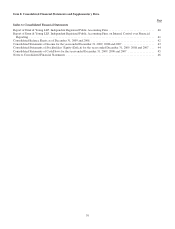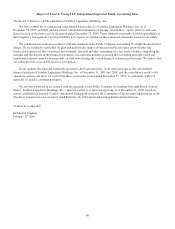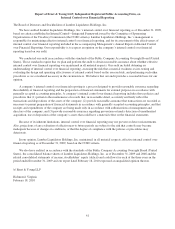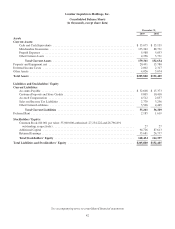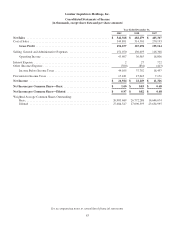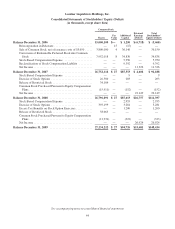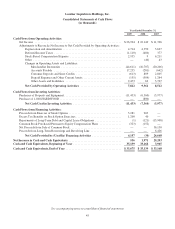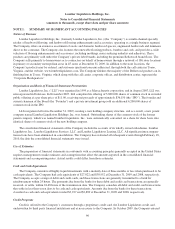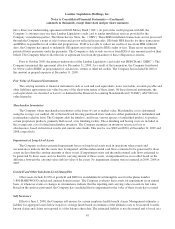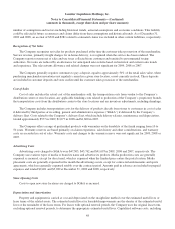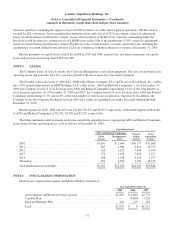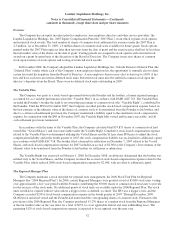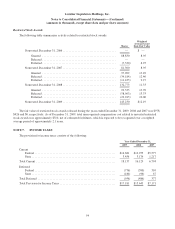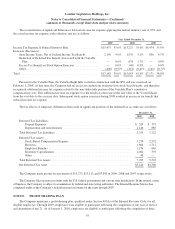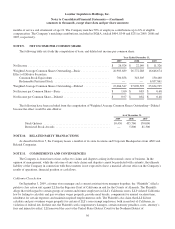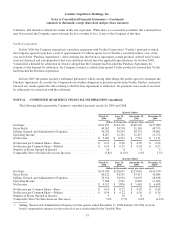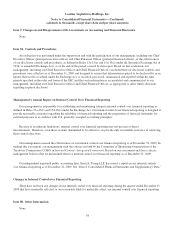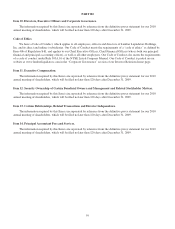Lumber Liquidators 2009 Annual Report Download - page 55
Download and view the complete annual report
Please find page 55 of the 2009 Lumber Liquidators annual report below. You can navigate through the pages in the report by either clicking on the pages listed below, or by using the keyword search tool below to find specific information within the annual report.
Lumber Liquidators Holdings, Inc.
Notes to Consolidated Financial Statements—(Continued)
(amounts in thousands, except share data and per share amounts)
those related to the Company’s integrated information technology solution, are capitalized from the time that technological
feasibility is established until the software is ready for use. The estimated useful lives are generally as follows:
Years
Vehicles (including Forklifts) ............................................ 5to7
Finishing Equipment ................................................... 5
Office Equipment ..................................................... 5to7
Computer Software .................................................... 3to10
Computer Hardware ................................................... 5
Store Fixtures ........................................................ 7
Leasehold Improvements ............................................... 1to15
Operating Leases
The Company has operating leases for its stores, Corporate Headquarters and certain equipment. The lease agreements
for certain stores contain rent escalation clauses and rent holidays. For scheduled rent escalation clauses during the lease
terms or for rental payments commencing at a date other than the date of initial occupancy, the Company records minimum
rental expenses on a straight-line basis over the terms of the leases in SG&A. The difference between the rental expense and
rent paid is recorded as deferred rent in the consolidated balance sheets.
Stock-Based Compensation
The Company records compensation expense associated with stock options and other forms of equity compensation in
accordance with FASB ASC 718. The Company issues incentive awards in the form of stock options and restricted stock
awards to employees and non-employee directors. The Company recognizes expense for its stock-based compensation based
on the fair value of the awards that are granted. Measured compensation cost is recognized ratably over the requisite service
period of the related stock-based compensation award.
Income Taxes
Income taxes are accounted for in accordance with FASB ASC 740 (“ASC 740”). Income taxes are provided for under
the asset and liability method and consider differences between the tax and financial accounting bases. The tax effects of
these differences are reflected on the balance sheet as deferred income taxes and valued using the effective tax rate expected
to be in effect when the differences reverse. ASC 740 also requires that deferred tax assets be reduced by a valuation
allowance if it is more likely than not that some portion of the deferred tax asset will not be realized. In evaluating the need
for a valuation allowance, the Company took into account various factors, including the expected level of future taxable
income. If actual results differ from the assumptions made in the evaluation of the valuation allowance, a change in the
valuation allowance will be recorded through income tax expense in the period such determination is made.
The Company classifies interest and penalties related to income tax matters as a component of income tax expense.
Net Income per Common Share
Basic net income per common share is determined by dividing net income by the weighted average number of common
shares outstanding during the year. Diluted net income per common share is determined by dividing net income by the
weighted average number of common shares outstanding during the year, plus the dilutive effect of common stock
equivalents, including stock options and restricted stock awards. Common stock and common stock equivalents included in
the computation represent shares issuable upon assumed exercise of outstanding stock options, release of restricted stock and
conversion of redeemable preferred stock, except when the effect of their inclusion would be antidilutive.
49


